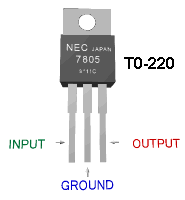Voltage Regulator Component
- They are electronic elements that output a constant voltage regardless of the input.
- The input voltage must be greater than the output voltage
- They are widely used in designing power supply circuits and voltage sources (Power Supply).
Symbol

Voltage Regulator Symbol
Voltage regulators typically have three legs, one for ground and separate inputs and outputs.
Types of Voltage Regulators
Voltage regulators are commonly identified by part numbers like 7805, 7806, etc., indicating their input and output voltage specifications.
| Type | Min Input Voltage | Output Voltage |
|---|---|---|
| 7805 | 7V | +5V |
| 7806 | 8V | +6V |
| 7808 | 10V | +10V |
| 7809 | 11V | +11V |
| 7812 | 15V | +15V |
| 7815 | 18V | +18V |
| 7818 | 22V | +22V |
| 7824 | 30V | +30V |
Can I get voltage in minus?
Yes, other types of voltage regulators provide negative output voltages. These regulators have part numbers like 7905, 7906, etc.
However, it's essential to note that the pin configuration for these negative voltage regulators may be different from the standard ones mentioned earlier.
Please refer to the datasheet or product documentation for the correct pin arrangement when using negative voltage regulators.
Main Circuit

Voltage Regulator Main Circuit
In this circuit, the input voltage to the voltage regulator is 12+ Volts, and the output will be 9+ Volts. The capacitors are used to remove any noise from the circuit, and it is recommended to use 100nF capacitors for this purpose.
What do I need from the Datasheet?
To select the appropriate voltage regulator for your application, you will need the following information from the datasheet:
- Input Voltage Range
- Output Voltage
- Output Current Capacity
- Dropout Voltage (The minimum voltage difference between the input and output required for the regulator to function properly)